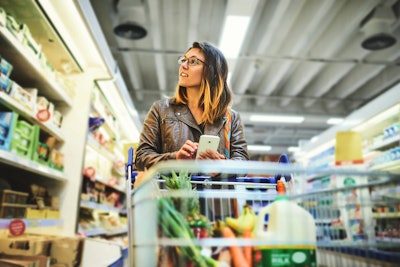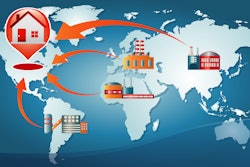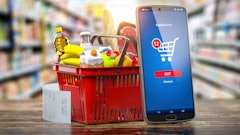
By now, the whole world is familiar with the opulence of the online grocery market. In 2021 alone, it totaled $97.7 billion in sales via pickup, delivery and direct-to-consumer channels. But the wealth of profits hidden deep in grocery market data is still quite untapped.
Whether enhancing operational efficiency, allowing for personalized marketing messages or helping to tackle consumer pain points, the benefits of data are alluring. In the food and beverage industry, however, grocery stores and supermarkets still struggle to turn their piled data into actionable insights
Let’s look at what data to collect and how to derive practical direction for grocery store management.
Investing in smart inventory management
Inventory management involves handling everything from ordering stock, putting it into catalogs and selling to the customer. Well-planned inventory management should lead to the right stock, at the right levels, at the right time and harmonize both costs and prices.
In the food and beverage industry, the customer experience stands and falls with the inventory. In 2021, two-thirds of in-store shoppers and 51% of online customers experienced products being out of stock, leading to disgruntled customers and extreme losses for supermarkets across the US.
A well-managed inventory is an investment, not an expenditure. Poorly managed inventory can lead to food waste, high storage costs for unwanted products and devastating effects on customer loyalty. But how can one achieve good, if not excellent, inventory management? With solid data analytics.
By running systematic data analysis, stores can access up-to-date information on products in excess, low stock levels and spoilage. Those stock issues depend on seasonality, customer demands and product competitiveness. Therefore, stores need to collect data on incoming and outgoing inventory and sales velocity and identify recurring patterns.
Yet, supermarkets and grocery stores face hardship in accurately predicting future inventory levels, as they have more time-sensitive commodities than online marketplace retailers. Additionally, the food business is low margin, so grocers shouldn't have to lose their bottom line to miscalculations. If an entire order of peaches or seafood spoils at the deli counter, it's more costly than if there are too many mouse cables lying around in an electronics store.
Here are practical tips for more accurate forecasting:
- Grocers can leverage data Monday through Sunday, keep track of events and add manual insights weekly. They must track their inventory changes perpetually and be sensitive to even minor fluctuations.
- For fresh products, stores can offer fewer products with a more accurate stock. For example, instead of providing all types of avocados, they can focus on one high-quality yield and offer customers different ripeness levels.
- It is rarely sufficient to analyze internal inventory changes. Additionally, grocers need to keep an eye on producers’ delivery times and seasonal volume changes. Strategic supplier diversification allows contacting alternative producers if one fails to deliver in time.
- Marketing strategies can guarantee more profitable inventory management. For example, by heavily advertising products in excessive inventory and offering a discount, when stock runs low, customers can be redirected to alternative products.
- Stores can use the same strategy for perishable products, such as a 50% discount on milk cartons a few days before their estimated expiration date. Some customers are constantly on the lookout for such offers and fresh goods won't spoil.
Making an accurate inventory forecast is a challenge, but one that is worth taking on. Luckily, there’s a solution at arm’s length -- smart inventory management systems. By using off-the-shelf software integrating all channels – online, in-app or cashier – supermarkets can get the necessary capabilities for driving deep analytics quicker.
Achieving targeted marketing
The second big area where data is quintessential is marketing personalization. Customizing the messaging can improve the customer experience and help stores drive consistent sales. For example, 80% of frequent shoppers say they only shop with brands that personalize their experience. Most digital personalization engines look at previous purchase patterns, cart abandonment, and location to identify customer preferences and send personalized notifications about current discounts to their mobile devices.
The biggest challenge for supermarkets is to ensure that customers always log in to their user accounts when making purchase decisions or browsing through online catalogs. Checkout systems in digital stores and the physical checkout can only merge data about previous purchases if they are always linked to the current customer.
To achieve higher marketing success rates, stores need to work out new sales strategies. One way is to target lower-profile customers (like infrequent customers) with less costly marketing efforts while expanding their budgets and messaging approach to routine customers who make high-volume orders. And it can be just as worthwhile to play with different optimization scenarios and test innovative sales ideas.
Data as the trump card of profitability
Lastly, data is needed for boosting the profitability of the online business and ordering options. The need for this is enormous. Even though the rapid growth of digital grocery shopping in 2020 was tremendous for revenue (+9.5%), it has not translated into profit due to losses on online orders (-70%).
Accurate data on order quantity, delivery and maintenance costs, customer behavior and so on help identify how much a business must charge for curbside or other delivery options to be profitable. Should each order have a minimum fee or subscription-based models? Only deep analytics will enable sufficient insights to optimize per store model and customer base.
By testing various options, grocers can compare the costs of hiring delivery drivers or organizing pick-and-pack service in-house and choose the option that has positive revenue effects and fits customers’ demands. And, by collecting geographic data on where people order from, stores can even make larger-scale decisions, such as opening or closing branches across cities or becoming a digital-only store one day.
Whether it's improving inventory, marketing or sales strategy, it's high time that grocery stores use the data flying under their radar to their advantage. Times have changed, and it's no longer enough to rely on traditional practices and derive sales strategies from shallow wisdom. Grocers must decide what works best for their store. And they can only do that by collecting data, testing different approaches and figuring out which method works best for them and their customers.



















